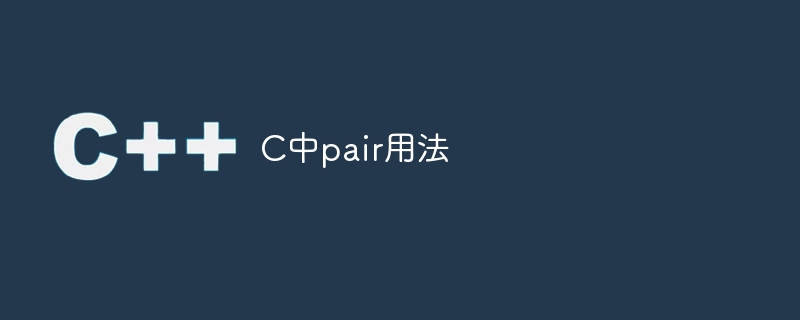

The usage of pair in C requires specific code examples
In C language, we often need to save two objects of different types in one program. In this case Next we can use pair to achieve this. Pair is a structure type in C language, used to store two objects of different types. This article will introduce the basic usage of pair and provide specific code examples.
First, in order to use pair, we need to include the header file
The following is the definition of the pair structure:
typedef struct
{
void *first; // 第一个对象的指针
void *second; // 第二个对象的指针
} Pair;There are two pointer variables first and second in the pair structure, pointing to the first object and the second object respectively.
Next, we can use pair to save two objects of different types, as shown below:
Pair mypair; int a = 10; char b = 'c'; mypair.first = &a; mypair.second = &b;
In the above example, we created a pair structure variable mypair and set The addresses of integer variable a and character variable b are assigned to the first and second pointers of mypair.
When we need to access the object saved in the pair, we can obtain the value of the object by dereferencing the pointer, as shown below:
int value1 = *(int*)(mypair.first); char value2 = *(char*)(mypair.second);
In the above example, by dereferencing the first pointer and second Pointers, we can get the values of integer variable a and character variable b.
In addition to manually accessing the objects in the pair, you can also use the functions provided by pair to operate the pair, as shown below:
Pair make_pair(void *first, void *second); void *pair_get_first(Pair pair); void *pair_get_second(Pair pair); void pair_set_first(Pair pair, void *first); void pair_set_second(Pair pair, void *second);
The make_pair function is used to create a pair structure and Pointers to two objects are passed in as parameters, and a structure of type Pair is returned. The pair_get_first function and the pair_get_second function are used to obtain the pointers of the first object and the second object saved in the pair respectively. The pair_set_first function and the pair_set_second function are used to modify the first object and the second object saved in the pair.
The following is a specific code example:
#include <stdio.h>
#include <utility.h>
int main()
{
Pair mypair;
int a = 10;
char b = 'c';
mypair = make_pair(&a, &b);
int value1 = *(int*)(pair_get_first(mypair));
char value2 = *(char*)(pair_get_second(mypair));
printf("Value 1: %d
", value1);
printf("Value 2: %c
", value2);
int c = 20;
char d = 'd';
pair_set_first(mypair, &c);
pair_set_second(mypair, &d);
value1 = *(int*)(pair_get_first(mypair));
value2 = *(char*)(pair_get_second(mypair));
printf("Modified Value 1: %d
", value1);
printf("Modified Value 2: %c
", value2);
return 0;
}In the above code example, we use the related functions of pair to create, obtain and modify the objects saved in the pair. The program running results are as follows:
Value 1: 10 Value 2: c Modified Value 1: 20 Modified Value 2: d
Through the above example, we can see the basic usage of pair in C language. Pair provides a convenient way to save two objects of different types, and the saved objects can be obtained and modified through pointer operations. I hope this article will help you understand the usage of pair!
The above is the detailed content of How to use pair in C. For more information, please follow other related articles on the PHP Chinese website!




